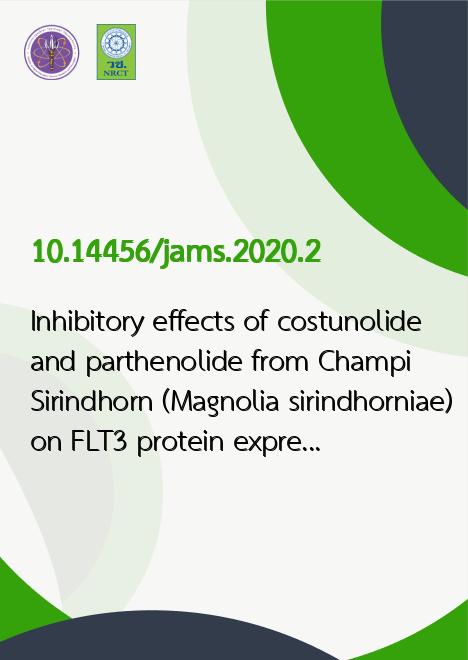
|
Inhibitory effects of costunolide and parthenolide from Champi Sirindhorn (Magnolia sirindhorniae) on FLT3 protein expression in EoL-1 leukemic cells |
|---|---|
| รหัสดีโอไอ | |
| Creator | 1. Sawalee Saosathan 2. Jalernsri Khounvong 3. Methee Rungrojsakul 4. Trinnakorn Katekunlaphan 5. Singkome Tima 6. Sawitree Chiampanichayakul 7. Songyot Anuchapreeda |
| Title | Inhibitory effects of costunolide and parthenolide from Champi Sirindhorn (Magnolia sirindhorniae) on FLT3 protein expression in EoL-1 leukemic cells |
| Publisher | Faculty of Associated Medical Sciences, Chiang Mai University |
| Publication Year | 2563 |
| Journal Title | Journal of Associated Medical Sciences |
| Journal Vol. | 53 |
| Journal No. | 1 |
| Page no. | 8-18 |
| Keyword | Magnolia sirindhorniae, costunolide, parthenolide, Feline McDonough Sarcoma (FMS)-like tyrosine kinase 3, leukemia, EoL-1 |
| URL Website | https://www.tci-thaijo.org/index.php/bulletinAMS/index |
| Website title | Journal of Associated Medical Sciences |
| ISSN | 25396056 |
| Abstract | Background: FLT3 (Fms-like tyrosine kinase 3) belongs to the class III receptor tyrosine kinase that is involved in hematopoietic progenitor cell proliferation. It is a prognostic marker for acute myeloblastic leukemia (AML). To date, chemotherapy has been the most frequently used treatment for leukemia. It has had a very good outcome in the early stages of treatment. However, the main problem of chemotherapy is the side effects for leukemia patients, as it may also cause drug resistance after long time treatment. Magnolia (Magnolia spp.) is a medicinal plant and has been used as traditional medicine in China, Japan, and Thailand. It is used for treatment of gastrointestinal disorders, anxiety, allergic disease, etc. Objective: Effect of crude fractional extracts and purified active compounds from Magnolia sirindhorniae Noot. & Chalermglin (a new species of Magnoliae spp. which was discovered first in Thailand) were investigated for their cytotoxicity, leukemic cell proliferation, and FLT3 protein suppression in EoL-1 cells. Crude fractional extracts from leaves (fraction No. 1-3), twigs (fraction No. 4-6), and stems (fraction No. 7-9) were fractionated by hexane (fraction No. 1, 4, 7), ethyl acetate (fraction No. 2, 5, 8), methanol (fraction No. 3, 6, 9). The costunolide (1) and parthenolide (2) were purified from n-Hexane fraction from leaves and ethyl acetate fraction from twigs, respectively by column chromatography. Cytotoxicities against leukemic cells were determined by using MTT assay. Results: Fraction No. 1, 2, 4, 5, 7, 8, costunolide (1), and parthenolide (2) showed strong cytotoxic effects on EoL-1 cells. Furthermore, the non-cytotoxic concentration (20% inhibitory concentration (IC20) values) also decreased FLT3 protein expressions and total cell numbers of EoL-1 cells after treatments. Interestingly, fraction No. 1, 5, costunolide (1), parthenolide (2) decreased the FLT3 protein levels in a time- and dose-dependent manner. Conclusion: In summary, costunolide and parthenolide are effective compounds from leaves and twigs of M. sirindhorniae to suppress FLT3 protein expression and cell proliferation. |